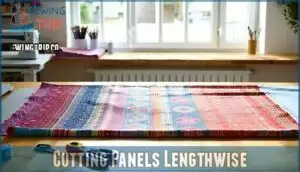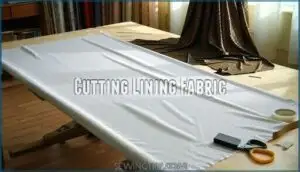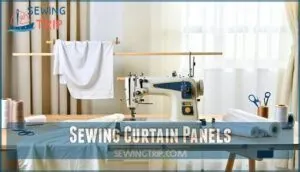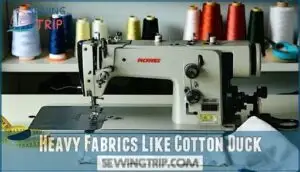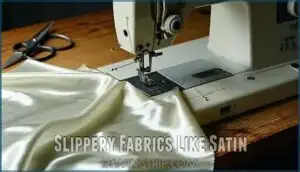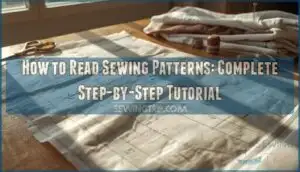This site is supported by our readers. We may earn a commission, at no cost to you, if you purchase through links.

Select medium-weight fabrics like cotton or linen for beginners—they’re forgiving and hang beautifully.
Always check the fabric’s grain direction and cut panels consistently to avoid twisted seams that’ll make your curtains look wonky.
Pre-wash your fabric to prevent shrinkage surprises later.
For measuring, add 4-6 inches to your window width for proper fullness and remember to account for hem allowances.
Keep your cutting lines straight using a rotary cutter and quilting ruler.
The secret to professional-looking curtains lies in the details most sewists overlook.
Table Of Contents
Key Takeaways
- Choose the right fabric weight and grain direction – You’ll want medium-weight fabrics like cotton or linen for easy handling, and always cut along the lengthwise grain to prevent twisted seams that make curtains hang crooked.
- Pre-wash your fabric before cutting – Natural fibers like cotton and linen shrink 3-10%, so you’ll avoid costly sizing mistakes by washing the fabric first to prevent post-construction surprises.
- Add proper allowances for professional results – You’ll need 4-6 inches of extra width for fullness, 7 inches of total length for hems, and consistent seam allowances to achieve that custom-tailored look.
- Use sharp tools and press thoroughly – You’ll get clean, straight cuts with rotary cutters and quilting rulers, then press each seam and hem with steam to transform amateur work into professional-looking curtains.
Choosing Curtain Fabric
Your fabric choice makes or breaks your curtain project. The right material guarantees smooth sewing, beautiful drape, and long-lasting results that transform your space.
Fabric Weight and Thickness
Understanding fabric weight and thickness gives you control over your curtain’s performance.
Fabric Density and Thread Count determine how much light passes through, while Weave Types affect drape.
**Density drives light control, weave creates curtain magic.
Material Selection based on Weight Factors guarantees your curtains meet specific fabric needs.
Lightweight fabrics under 150 GSM offer airy movement, medium-weight provides balanced function, and heavyweight delivers superior light-blocking power.
Consider fabric transparency to optimize natural light.
Fabric Grain and Grainline
Most fabrics have three grain directions that’ll make or break your curtains.
The lengthwise grain runs parallel to the selvage and offers maximum fabric stability, preventing skewing when you hang your panels.
Always cut your curtain pieces following this grain direction for professional results.
Understanding grain eliminates wonky, twisted curtains that never hang straight, no matter how perfectly you measure, and helps achieve professional results.
Nap and One-Way Designs
Fabric orientation matters when you’re working with nap and one-way designs.
These fabric patterns have a directional quality that affects how light reflects off the surface. Handle them carefully to maintain consistent appearance.
- Check Nap Direction by running your hand across the fabric surface
- Verify Print Matching aligns properly when cutting multiple panels
- Plan Design Alignment before cutting to avoid costly mistakes.
One-way designs require all panels face the same direction for uniform curtains.
Keep all panels facing the same direction for uniform, professional-looking curtains.
Plaids and Diagonal Prints
Plaid matching demands careful fabric selection and precise pattern alignment.
You’ll need to take into account pattern repeats when calculating yardage—diagonal prints require 25% more fabric than straight designs.
Match horizontal lines at seams for seamless curtain panels. Cut all pieces in the same fabric orientation to maintain consistent diagonal cutting direction and prevent mismatched stripes.
Measuring for Curtains
Getting your measurements right is the foundation of professional-looking curtains that hang beautifully.
You’ll need to measure both your window width and desired curtain length carefully, then add the proper allowances for hems and headers to guarantee your finished curtains fit perfectly.
Measuring Window Width
Measure your window’s width accurately using a measuring tape to determine curtain width requirements.
Start by measuring the actual window opening, then add 4-6 inches on each side for proper coverage and neat stacking.
Multiply your final measurement by 1.5 to 3 times for fabric fullness. Room dimensions affect fabric calculation substantially, so accuracy tools guarantee precise curtain measurements for perfect window design results, ensuring perfect window design.
Calculating Fabric Length
When calculating fabric length for curtains, you’re basically doing sewing math to determine your fabric requirements.
Start by measuring from your curtain rod to your desired endpoint, then add extra inches for hems and headers.
Here’s your fabric calculation roadmap:
- Measure the drop – From rod to floor (or desired length)
- Add hem allowances – Typically 6-8 inches total for top and bottom
- Calculate repeats – For patterned fabrics, factor in pattern matching
Getting curtain lengths right prevents costly mistakes and makes certain your panels hang beautifully without looking skimpy or excessive.
Determining Curtain Height
Getting your curtain height right sets the foundation for professional-looking window treatments.
Start by measuring from your ceiling to your desired floor level, then add seven inches for proper folded hems.
This measurement becomes your curtain length guideline for cutting fabric panels accurately.
| Curtain Style | Measurement Point | Length Addition |
|---|---|---|
| Sill Length | Window sill | +1 inch |
| Apron Length | 4-6" below sill | +2 inches |
| Floor Length | Floor level | +7 inches |
| Puddle Length | Floor level | +12-15 inches |
Rod placement affects your final curtain height calculation, so confirm your hardware position before making any cuts to ensure a professional-looking result.
Adding Allowances for Hems
Now you’re ready to calculate hem allowances—the fabric insurance that prevents disaster.
Professional curtain makers add specific seam margins to guarantee perfect folded edges and proper curtain depths.
Here’s your hemming roadmap:
- Top hem allowance: Add 4 inches for rod pocket creation and header space
- Bottom hem allowance: Include 4-6 inches for double-fold hemming techniques
- Side seam allowance: Reserve 1 inch total (½ inch per side) for clean edges
- Lining adjustments: Cut lining fabric 3 inches shorter than main curtain hems
These measurements give you flexibility during final fitting while guaranteeing your sewing techniques produce professional curtain hems every time.
Cutting Curtain Fabric
Proper cutting technique sets the foundation for professional-looking curtains that hang beautifully and last for years.
You’ll need to cut panels lengthwise, square your edges perfectly, and handle directional prints with care to achieve that custom-tailored appearance.
Cutting Panels Lengthwise
Once you’ve finalized your measurements, position your fabric on a cutting mat for Panel Cutting precision.
Use rotary cutting tools or fabric scissors to make Straight Cuts along the grain, ensuring your measuring tape guides each lengthwise cut.
This Fabric Squaring technique prevents wonky panels that’ll haunt your hanging dreams later.
Squaring Edges for Even Drape
Once you’ve cut your panels lengthwise, straight edges become your foundation for professional results.
Crooked cuts create uneven hems that’ll haunt you through every hanging adjustment.
Edge Squaring Essentials:
- Use a hard ruler or T-square – Position against fabric grain for perfect 90-degree angles
- Mark cutting lines with fabric chalk – Creates visible guides for precise fabric cutting
- Cut one layer at a time – Prevents shifting that compromises drape control
- Check corners with a quilter’s square – Guarantees true right angles for proper fold techniques
- Press edges immediately after cutting – Seam pressing prevents fraying and maintains clean lines
Accurate measurements are vital, and using a T-square tool guarantees precise cuts and professional-looking results.
Cutting Lining Fabric
Precision matters when cutting curtain lining.
Cut your lining fabric three inches shorter than your main curtain fabric to guarantee proper drape and prevent show-through.
Use sharp fabric scissors or a rotary cutter along the fabric grain for clean edges.
Match your seam allowance measurements between both fabrics.
This technique creates professional-looking lined curtains with perfect proportions.
To achieve accurate results, consider the fabric cutting guide for measuring and marking fabric correctly to ensure accurate results.
Handling Directional Prints
Directional prints present unique challenges when creating curtains, but proper handling guarantees stunning results.
You’ll need to identify fabric patterns with clear print orientation before cutting – look for motifs that appear upside-down when fabric direction changes.
Plan your fabric layout carefully, positioning all panels with pattern matching aligned.
This prevents directional textures from creating visual chaos across your finished curtains.
Understanding fabric orientation tips is vital for achieving professional-looking results with clear print orientation and proper fabric layout.
Sewing Curtain Panels
Once you’ve cut your curtain panels, the real magic happens when you transform separate pieces into polished window treatments.
Proper sewing techniques guarantee your curtains hang beautifully and last for years of daily use, which is crucial for polished window treatments.
Pinning Fabric and Lining
Properly pinning fabric and lining together sets the foundation for professional-looking curtains.
Your fabric choice and lining attachment technique determine the final drape quality.
- Fabric Alignment: Match selvage edges and square corners before pinning
- Pin Placement: Position pins perpendicular to seam lines every 4-6 inches
- Seam Allowance: Maintain consistent 1/2-inch margins using folding techniques for accuracy
Sewing Side Hems and Seams
Strong seams form the foundation of professional curtains.
Start with a 1/2-inch seam allowance for clean, durable edges. Use a longer stitch length (setting 3-4) when hemming to prevent fabric fray and guarantee smooth lines.
Choose thread that matches your fabric weight—cotton thread for natural fibers, polyester for synthetics.
Proper hem techniques include folding raw edges twice, pressing thoroughly, then stitching close to the fold for invisible seams. Proper hem techniques and using the right thread are crucial for a professional finish, which is why strong seams are important.
Creating Rod Pockets
Rod pockets transform your curtain fabric into functional window treatments through strategic fold techniques.
You’ll create the perfect pocket depth by measuring your sewing rod diameter and adding extra room for smooth gliding.
- Measure pocket depth – Add 1/2 inch to your rod diameter for easy movement
- Mark fold lines – Use chalk to indicate where fabric folds over for the rod pocket
- Create double fold – Fold fabric twice to hide raw edges and strengthen the pocket
- Maintain hem allowance – Keep consistent measurements throughout your sewing techniques
- Press before sewing – Iron creases sharp for professional-looking pocket styles
Attaching Pleater Tape
Master the art of pleat perfection with proper pleater tape attachment.
Position your tape along the top hem’s wrong side, guaranteeing the hook loops face outward.
Secure with straight stitches, keeping edges aligned.
Insert curtain hooks into designated loops, creating your desired pleat styles.
These folding techniques transform ordinary panels into professionally crafted window treatments with crisp, uniform pleats.
Achieving professional results requires understanding fabric selection tips to guarantee the best outcome for your sewing projects, ensuring a successful completion of your sewing projects.
Working With Different Fabrics
Each fabric type requires specific techniques to achieve professional results.
You’ll need to adjust your sewing approach based on whether you’re working with heavy cotton duck, delicate sheers, insulating thermal materials, or slippery fabrics like satin.
Heavy Fabrics Like Cotton Duck
Heavy fabrics like cotton duck require special handling techniques to achieve professional results.
Cotton duck’s thickness and dense weave demand specific adjustments to your sewing approach for successful curtain construction.
Here are five essential techniques for working with heavy fabrics:
- Use a heavy-duty sewing machine with strong motor power to handle multiple fabric layers without strain
- Switch to size 90/14 or 110 needles designed for thick materials to prevent skipped stitches
- Adjust presser foot pressure and increase stitch length for better fabric feeding through the machine
- Replace pins with Wonder clips to secure thick layers without creating permanent holes in the fabric
- Support fabric weight with tables or ironing boards to prevent seam distortion on large panels
Understanding proper sewing with heavy fabrics techniques is essential for mastering thick materials.
Sheer Fabrics for Light Control
Sheer fabrics offer delicate light control while maintaining privacy.
These transparent materials require gentle handling—use sharp pins, lightweight thread, and a walking foot to prevent puckering.
Choose voile, chiffon, or organza for window treatments that filter harsh sunlight beautifully.
Layer sheer curtains with heavier panels for versatile lighting options throughout the day.
When selecting sheer fabrics, consider the sheer curtain options available to achieve the desired effect.
Thermal Fabrics for Insulation
Thermal fabrics transform your curtains into energy-saving powerhouses.
Choose wool, polyester, or velvet for superior heat retention and fabric density.
Add thermal lining or blackout lining behind your main fabric to boost insulation materials performance.
These UV protective fabrics can reduce heat loss by 25% while maintaining fabric insulation properties that lower energy costs year-round, using thermal fabrics.
Slippery Fabrics Like Satin
Slippery fabrics like satin require special sewing techniques to prevent fabric slippage during construction.
Use sharp pins and a walking foot attachment on your sewing machine to maintain control. Place tissue paper between fabric layers while stitching, then tear it away afterward.
Handle satin gently, securing edges with basting stitches before final seaming to achieve professional results.
Finishing Curtain Details
The final details separate amateur curtains from professional-looking window treatments that elevate your entire room.
These finishing touches guarantee your curtains hang beautifully and maintain their shape for years to come, which can be considered professional-looking window treatments that include finishing touches.
Pressing Seams and Hems
Every professional seamstress knows this golden rule: pressing transforms amateur work into masterpiece curtains.
Use steam settings for cotton and linen, but place a pressing cloth over delicate fabrics.
Press seams open first, then fold hems with precision, and iron each seam allowance flat before topstitching.
Clip curved seams to eliminate bulk, as this ironing technique guarantees wrinkle removal and fabric smoothing for flawless results.
Adding Weights to Corners
Two curtain weights strategically placed in bottom corners transform flimsy panels into professional-looking drapes.
Choose weighted tape, chain weights, or even coins sewn into fabric pouches for effective weight distribution.
This corner reinforcement guarantees fabric stability and proper curtain balance, preventing lightweight materials from floating or bunching.
Master weight management techniques to achieve that coveted designer drape every time.
Understanding the importance of proper fabric choice is vital for a successful curtain sewing project.
Attaching Ribbon or Trim
Once you’ve secured the weights, decorative accents transform your curtains from functional to fabulous.
Strategic ribbon placement and trim selection elevate your project’s aesthetic appeal.
Here are four professional techniques for attaching decorative elements:
- Position trims along folded edges – Align decorative trims with pressed seams for clean, professional lines that won’t shift during hanging
- Use coordinating sewing techniques – Match thread color to trim and use appropriate stitch settings for different materials like tassels or braided edges
- Secure decorative edges with precise clipping – Clip curves and corners before pressing to eliminate bulk and guarantee smooth application
- Apply consistent pressing throughout – Steam each attached element while avoiding heat damage to delicate trims or metallic accents
Hanging Curtains for Final Adjustments
Before hanging your curtains, insert curtain hooks into pleater tape loops for professional pleat adjustments.
Attach curtain brackets and position your curtain rods at the desired height.
During curtain installation, temporarily hang panels to evaluate length and fold styles.
Check for even drape and make final curtain adjustment by adding curtain weights to lightweight corners if needed, ensuring a professional and even drape with the use of curtain weights.
Curtain Fabric Considerations
Selecting the right fabric goes far beyond choosing a pretty pattern—it’s the foundation that determines how your curtains will hang, last, and function in your space.
Understanding fabric properties like shrinkage, drape, and room-specific requirements will save you from costly mistakes and guarantee your handmade curtains look professionally crafted.
Fabric Shrinkage and Fade Resistance
Most natural fabrics shrink 3-10% after washing, while synthetic materials resist shrinkage completely.
Cotton duck and linen require prewashing before cutting to prevent post-construction surprises.
For fade prevention, choose polyester blends or UV-treated fabrics rated 6 or higher.
Cold water washing and air drying maximize textile durability and color fastness.
Fabric Drape and Movement
Understanding how fabric drape affects your curtains transforms ordinary windows into stunning focal points.
Different fabric types create distinct movement patterns that influence your room’s overall aesthetic.
Consider these drape characteristics when selecting your fabric:
- Fabric Flow – Lightweight cottons and linens create gentle, natural folds while heavier fabrics like canvas produce structured, dramatic pleats
- Movement Control – Slippery fabrics like satin flow freely but require careful handling, while textured weaves maintain their shape better
- Fullness Factor – Fabric weight determines how much material you’ll need; lighter fabrics require more fullness to achieve rich, luxurious drape styles
Choosing Fabric for Room Function
Room-specific fabric selection transforms curtain functionality from basic window coverage to purposeful design elements.
Each space demands different fabric characteristics: bedrooms need blackout materials for light control, while kitchens require moisture-resistant polyester blends.
Consider fabric weight for room acoustics—heavier textures dampen sound in offices.
Match fabric durability to room traffic, choosing sturdy cotton duck for family spaces, and ensure your fabric choice aligns with each room’s primary function and aesthetic goals, considering the need for light control and moisture-resistant properties to achieve the desired outcome, ultimately enhancing the room’s overall design elements.
Beginner-Friendly Fabric Options
Starting your curtain journey? Cotton blends and linen choices make perfect beginner fabric types.
These forgiving materials hide minor mistakes while offering excellent drape. Cotton duck, canvas, and cotton-linen blends provide manageable fabric weight for easy handling.
Skip silk or stretchy knits initially. Choose medium-weight curtain fabrics that don’t require special sewing tools or complex fabric care routines, making them ideal for beginners with forgiving materials.
Frequently Asked Questions (FAQs)
What is the best stitch for sewing curtains?
Use a straight stitch with a longer stitch length (5-4mm) for curtain construction.
This creates strong, durable seams that handle fabric weight well.
For hems, use a blind hem stitch to maintain clean edges and professional appearance.
What is the rule of thumb for curtains?
Measure twice, cut once, hang smart. You’ll need double the window width for fullness, add seven inches to length for hems, and hang curtains one-third above the frame for proportion.
What is the formula for making curtains?
Calculate your curtain’s finished width by measuring your window and multiplying by 5-3 for fullness. Add 7 inches to desired length for hems and headers. Cut fabric accordingly, then sew systematically.
How much extra fabric should I buy for mistakes?
Like a safety net for your creative dreams, buying an extra 10-15% fabric guards against cutting errors and measurement mishaps.
This buffer lets you confidently tackle your curtain project without worrying about running short, allowing you to have a buffer against potential mistakes.
Can I mix different fabric types in one curtain?
Yes, you can mix different fabric types in one curtain, but they should have similar weight and care requirements.
Combine complementary textures like cotton with linen or cotton with polyester.
Avoid mixing heavyweight with lightweight fabrics—they’ll hang unevenly and create an unprofessional look, as this will affect the overall appearance and care requirements.
Should I prewash curtain fabric before sewing?
Think of prewashing as laying a solid foundation—it’s absolutely essential for professional results.
You’ll want to prewash natural fibers like cotton and linen to prevent shrinkage after sewing, ensuring your curtains maintain their perfect fit.
What thread weight works best for curtain seams?
Use heavy-duty thread like 40-weight polyester or cotton-wrapped polyester for curtain seams. These threads handle the stress of heavy fabrics while providing durability that won’t break under weight.
How do I prevent fraying on raw fabric edges?
Finish fraying fabrics by serging edges, applying liquid fray check, or creating French seams. You’ll also secure raw edges with pinking shears or zigzag stitching for professional results.
Conclusion
Perfect curtain sewing doesn’t happen by accident—it’s the result of applying these fabric tips for sewing curtains with precision and care.
You’ve learned the fundamentals of fabric selection, proper measuring techniques, and cutting methods that separate amateur work from professional results.
Remember to pre-wash your fabric, respect the grain direction, and take time with your finishing details.
These fabric tips for sewing curtains will transform your window treatments from simple coverings into stunning focal points that enhance your home’s aesthetic appeal.
- https://www.alishataylor.com/5-best-fabric-for-curtains-your-guide-to-dreamy-drapery/
- https://maryclaret.com/blogs/news/selecting-the-correct-fabric-weight
- https://dolcewe.com/blogs/home-decor/understanding-the-weight-of-curtains-a-comprehensive-guide
- https://www.calicocorners.com/c-385-drapery-weight.aspx
- https://www.fabricguru.com/drapery-linings


